- Farmers and herders worldwide struggle to protect crops and livestock from predation, often killing potential predators in retaliation.
- Foxlights produce randomly blinking lights that resemble the flashlight/torch of a person walking by.
- With success in deterring foxes from attacking lambs, the concept is being tested with other crop and livestock predators in Africa and Asia.
Farmers and herders across the globe try numerous methods to protect their crops and livestock from predation. They make noise and sleep in their fields, and they use technologies ranging from scarecrows to pesticides to car horns to shotguns. Many prefer passive, non-lethal techniques – those that allow them to stay inside their homes at night and dissuade, rather than kill, the potential predator.
Some of these predators are endangered large mammals, so reducing conflict between farmers and wildlife is a critical conservation issue.
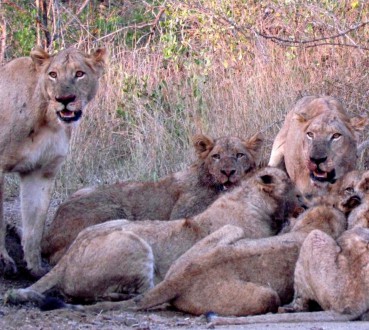 |
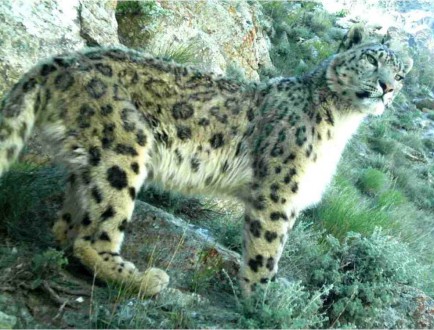 |
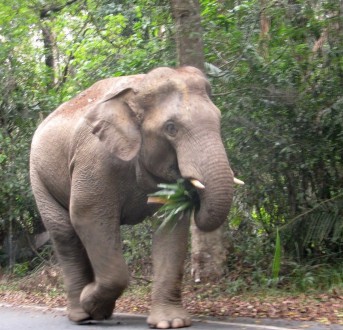 |
In Australia, a major culprit is the (non-endangered) European Red Fox (Vulpes vulpes), an invasive carnivore that has wreaked havoc on Australian domestic and wild fauna since its introduction there in the mid-1800s as a recreational hunting target. In addition to decimating native bird and small mammal populations, foxes aggravate farmers by preying on newborn lambs.
In an effort to combat this problem, Australian farmer Ian Whalan developed the Foxlight, a device that produces light at random intervals to emulate a moving person carrying a flashlight (torch).
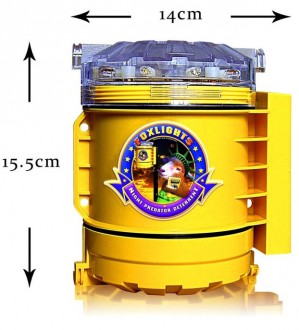
Each Foxlight contains 9 LED bulbs and a computer chip. The lights flash in varying blue and white sequences at 360 degrees and can be seen for about a mile (1.5 km). Light sensors turn the light on automatically at dusk and off at dawn so that they do not need to be revisited daily, and the required 6-volt batteries should last about 2.5 months each.
Each light sells for about $85USD, and they are now sold commercially in Australia, Canada, the US, the UK, Ireland, and other parts of Europe.
Placing flashing lights out at night to deter crop and livestock predators isn’t new: people have walked around with open flames, lanterns, or flashlights for centuries and, more recently, have put out continuously flashing lights and even reflective CDs to emulate the presence of human guard.
However, while these efforts initially discourage predators from approaching the area, the deterrence effect tends to disappear over time, as even disruptive stimuli, such as flashing lights or radio noise, may have limited effectiveness, as animal habituate to them.
How do these new automated lights reduce fox predation on lambs and other livestock?
Disruptive stimuli appear to be more effective when they are triggered by motion or change in a haphazard manner (Bangs and Shivik 2001). Whalen explained to wildtech.mongabay.com that he believes that his system’s variation in flashing pattern and light color effectively prevents habituation, as he says his system has remained effective for years. Changing light location may also prevent habituation.
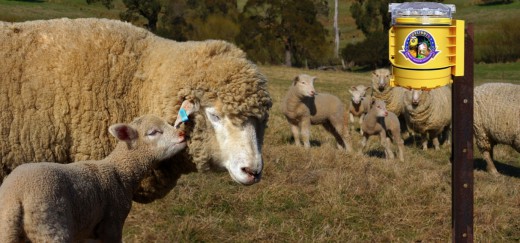
In addition to deterring foxes and coyotes in Australia, Whalan says the lights have been known to keep ducks out of rice fields. He has collaborated with Sandy Simpson of Green Rural African Development in Zambia in 2013 to test the effectiveness of Foxlights at preventing elephant crop raids.
Whalen hopes to use sales proceeds to subsidize distribution of Foxlights to support wildlife conservation work. He has donated lights to human-lion conflict mitigation projects in Kenya, as well as to the Snow Leopard Conservancy’s efforts to help yak farmers in Nepal. You can read more about their use with snow leopards in our Interview with Dr. Rodney Jackson.
Whalan stresses that Foxlights are not meant to replace protective measures, such as fences, only to enhance the effectiveness of existing techniques. While the systems are both so recently developed that formal studies have yet to be published, they are definitely predator-conflict mitigation technologies to keep in mind.
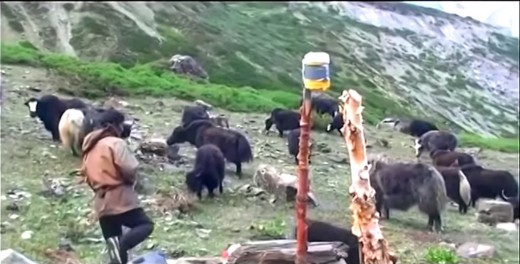
Other companies promote similar technologies, such as the Nite-Guard and Predator-Guard. The light systems vary slightly in design but have similar ends – to discourage a predator from approaching farms before it sees its potential prey.
We would like to know more about the long-term effectiveness of Foxlights or these other light systems, as there is a lack of current information on their use with native predators.
Could this be because it is widely accepted and that this technology is 100% effective? Are challenges and setbacks simply not reported?
Help us close the information gap! If you have used disruptive stimuli, such as these devices or similar technology, to reduce human-wildlife conflict, please tell us about your experience in the comments or forum!
Related Content:
Watch Ian Whalan’s mini-documentaries on Foxlights and their installation in Zambia and in Nepal.
Citations:
Bangs and Shivik, J. 2001. Managing wolf conflict with livestock in the Northwestern United States. Carnivore Damage Prevention News 3: 2-5.
Short, Kinnear, J.E., and Robley, A. 2002. Surplus killing by introduced predators in Australia—evidence for ineffective anti-predator adaptations in native prey species? Biological Conservation 103: 283-301.
Snow Leopard Conservancy’s trials of Foxlights in remote areas of the Himalayas.
Department of Sustainability, Environment, Water, Population and Communities, Department of the Environment, Australian Government. 2011. European red fox (Vulpes vulpes) Factsheet. Commonwealth of Australia.